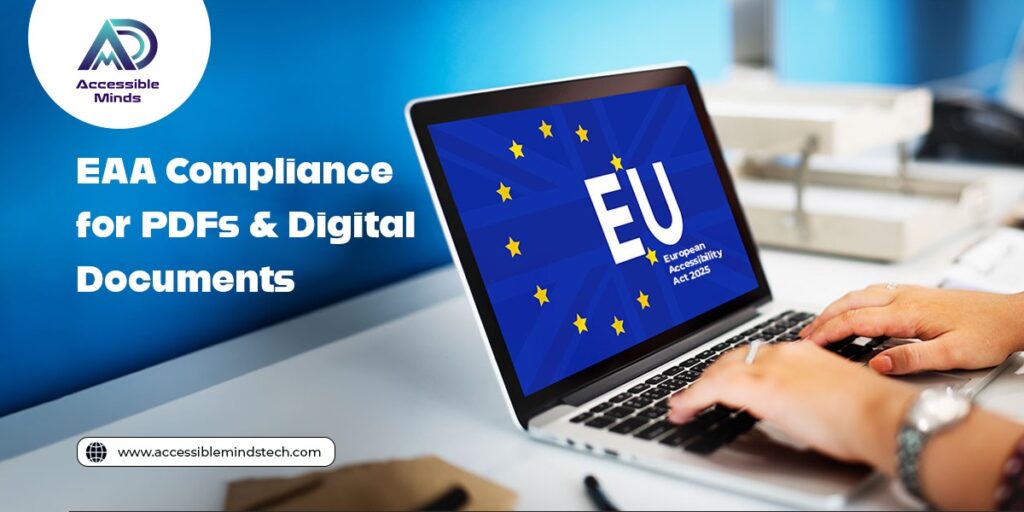The European Accessibility Act (EAA) is a major step toward a more inclusive digital world. With digital documents and PDFs being widely used across industries, ensuring their accessibility is no longer optional—it is a legal requirement. Businesses, government agencies, and service providers must now comply with EAA standards to avoid penalties and provide equal access to information for all users, including those with disabilities.
For organizations handling large volumes of digital documents, accessibility testing services play a crucial role in achieving compliance. These services specialize in identifying accessibility barriers, conducting audits, and implementing solutions that make PDFs and digital documents accessible to everyone.
In this blog, we will explore what EAA compliance means for PDFs and digital documents, common accessibility challenges, key compliance requirements, and best practices for ensuring accessibility.
Understanding EAA Compliance for Digital Documents
The European Accessibility Act (EAA) was introduced in 2019 and will be fully enforced by 2025. It aims to make products and services, including digital content, accessible to people with disabilities. The act applies to businesses operating within the European Union (EU) that provide:
- E-books and digital publications
- Banking, financial, and insurance services
- E-commerce platforms
- Public sector and government documents
- Customer service communications
Since PDFs and digital documents are key components of these services, they must be fully accessible according to Web Content Accessibility Guidelines (WCAG) 2.2 and PDF/UA (Universal Accessibility) standards.
Common Accessibility Challenges in PDFs & Digital Documents
Many digital documents fail to meet accessibility standards due to the following issues:
1. Lack of Proper Document Structure
Poorly structured PDFs make it difficult for screen readers to interpret the content. Issues include:
- Missing or incorrect heading levels
- Poorly defined sections and subsections
- Unlabeled tables and lists
2. Non-Descriptive Links and Buttons
- Generic labels like “Click Here” or “Read More” do not provide enough context for users relying on assistive technologies.
- All hyperlinks and interactive elements should have descriptive text explaining their purpose.
3. Images Without Alternative Text (Alt Text)
- Images, charts, and infographics must have alt text that describes their content for users who cannot see them.
- Complex data visualizations should have long descriptions or text-based alternatives.
4. Poor Color Contrast & Text Readability
- Low contrast between text and background can make content unreadable for users with visual impairments.
- Text should have a contrast ratio of at least 4.5:1, as per WCAG guidelines.
5. Missing Tags in PDFs
- PDFs must have proper tags to define the reading order, headings, lists, and tables for screen readers.
- Untagged PDFs are inaccessible and non-compliant with accessibility laws.
6. Inaccessible Forms
- PDF forms often lack keyboard navigability and proper labels, making them difficult for people using assistive technologies.
- Form fields must be clearly labeled and structured for easy interaction.
Key Compliance Requirements for EAA-Compliant Digital Documents
To achieve EAA compliance, organizations must follow these essential accessibility requirements:
1. Conformance to WCAG 2.2 AA & PDF/UA Standards
- WCAG 2.2 AA defines guidelines for making digital content accessible.
- PDF/UA (ISO 14289) ensures PDFs are structured and tagged correctly for assistive technologies.
2. Compatibility with Assistive Technologies
- Documents should be tested with screen readers like JAWS, NVDA, and VoiceOver.
- Interactive elements must be fully operable using only keyboard navigation.
3. Proper Heading and Document Structure
- Use H1, H2, H3 tags to organize content logically.
- Ensure text is readable, selectable, and resizable.
4. Text Descriptions for Images & Non-Text Elements
- Add alt text for images, icons, and diagrams.
- Use text-based alternatives for complex visual content.
5. Accessible Forms & Tables
- All form fields must be properly labeled and have clear instructions.
- Tables should have header rows and column labels for better readability.
6. Language Specification & Metadata
- Define the document language to improve text-to-speech accuracy.
- Include metadata for screen readers to recognize document properties.
How Accessibility Testing Services Can Help
Specialized accessibility testing services offer expertise in:
1. Accessibility Audits & Compliance Checks
- Evaluating PDFs and digital documents against WCAG 2.2 AA, EAA, and PDF/UA standards.
- Identifying violations and providing remediation plans.
2. Automated & Manual Testing
- Using accessibility testing tools like Adobe Acrobat Accessibility Checker, PAC 3, and axe-core.
- Conducting manual reviews with screen readers to ensure full compliance.
3. PDF Remediation Services
- Adding proper tags, headings, alt text, and form labels.
- Optimizing reading order and navigation for screen reader users.
4. Training & Consultation
- Providing workshops on document accessibility best practices.
- Helping organizations integrate accessibility into their content creation workflow.
Best Practices for Creating Accessible PDFs & Digital Documents
Here are some essential steps to ensure compliance:
- Use built-in accessibility features in tools like Adobe Acrobat, Microsoft Word, and Google Docs.
- Enable Optical Character Recognition (OCR) for scanned PDFs to make text selectable.
- Maintain proper heading hierarchy for easy navigation.
- Ensure hyperlinks are descriptive and meaningful.
- Use accessible fonts like Arial, Verdana, or Tahoma.
- Perform periodic accessibility audits with experts from accessibility testing services.
Conclusion
EAA compliance is crucial for making PDFs and digital documents accessible to all users, including those with disabilities. Organizations that fail to meet these requirements risk legal consequences and alienating a significant portion of their audience. By implementing WCAG 2.2 and PDF/UA standards, companies can ensure their digital documents are inclusive, user-friendly, and legally compliant.
Partnering with accessibility testing services can streamline the compliance process, ensuring seamless remediation, testing, and ongoing accessibility support. As we move toward a fully accessible digital future, prioritizing EAA compliance is no longer a choice—it’s a necessity.

